Wireline tractor tools offer increased capabilities beyond conventional intervention methods.
Brian Schwanitz, Welltec and Paal Ludvik Jørgensen, StatoilHydro
One of the biggest problems facing the oil and gas industry today is that water will eventually encroach on most producing wells and dominate the production. It is estimated that 250 million bbl of water is produced worldwide each day.1 Water production increases as wells mature, so that mature wells (>10 yrs) produce on average, about 9.5 bbl of water for every bbl of oil.
During the last decade, global watercut has increased to 75% from about 70%-and this figure is still rising due to maturing fields. Optimizing existing reservoir management methods and introducing new fields may bring the number down. When most of the world’s oil and gas production comes from fields that are more than 30-yr old,2 new solutions are in high demand. The growth in mature fields has led to growth in oil recovery techniques to ensure stable production.
StatoilHydro estimates that in the very mature fields of the North Sea some wells are producing 99% water, which severely limits revenues and causes operators to consider abandonment. When operators choose abandonment, the economic and environmental expenses are often higher than working over and optimizing existing wells.
ENVIRONMENTAL CHALLENGE
Remnant oil in produced water accounts for about 90% of the total oil discharged into the North Sea by the oil industry.1 Annual oil discharges to the sea amount to more than 3,000 tons, while the water-to-oil ratio has increased from 0.93 to 1.2 in two years (2004-2006).2 The Norwegian Petroleum Directorate expects the water-to-oil ratio to increase in the future.
Environmental regulations have been introduced to accurately measure oil in produced water; including the 2000/2001 Oslo Paris Convention (OSPAR) that put a limit on oil in disposed water. No offshore installation may exceed 30 mg/l of dispersed oil for produced water discharged into the sea.3 Furthermore, the Norwegian State Pollution Control Authority calls for zero harmful discharges into the sea. Stricter legislation concerning the treatment and/or disposal of produced water will probably lead to a substantial increase in water-handling costs.
Oil companies are seeking to restrain their energy consumption in surface processing-reducing their lifting costs-without sacrificing oil and gas recovery. This makes production dependent upon secondary methods to stimulate oil and gas rates and control water influx. The obvious remedy is to control the problem by isolating water production downhole and limiting the energy demand at the surface.
NEW, CLEAN TECHNOLOGY
New technology has made it possible to increase recovery rates while optimizing energy consumption. Welltec has developed and applied remote-controlled robotics, combining clean technology with environment consideration in oil and gas well interventions. This technology efficiently shuts off water-producing zones to optimize existing fields, instead of abandoning them.
The tools are based on standard electric wireline services, so that rig or coiled-tubing mobilizations are unneeded. These services are conveyed by the wireline tractor in high-angle wells or by gravity in low-angle wells. The best way to determine the water-production source is with production logs. After running them, engineers can design and implement an appropriate solution to shut off water production.
It is now possible to diagnose and solve water production problems with one electric line service mobilization using the wireline tractor. It can convey and activate isolation systems to manage water in horizontal and highly deviated wells, where conventional intervention methods have difficulties.
Wireline tractor technology allows mechanical interventions in horizontal wells, such as pulling, setting, shifting, cleaning and milling services. By using a Well Stroker, a hydraulic-stroking tool, with packers and attached straddles, selected water producing intervals can be isolated. In this way, produced water is reduced, water handling becomes manageable and well life is prolonged.
For example, a Statoil well producing since 1995 showed decreased production due to water influx from tubing leakage, causing temporary well abandonment. The tool helped isolate the water and leakage by installing two straddles of 26 ft and 72 ft, respectively. The watercut was reduced from 85% to 5%, while the oil rate increased 800%.
KEYHOLE SURGERY
If a downhole valve is no longer useful or cannot be manipulated due to scale buildup, an electric line milling tool can remove the obstruction. This “keyhole surgery” shows that the equipment can operate with a high degree of precision. Keyhole surgery is an important technique for controlling water, since operators can apply precision-controlled force to small, specific parts of the well. With a localized intervention approach, the risk of damaging the wellbore and reservoir are reduced, while also providing greater effectiveness, reliability and significantly fewer production shutdowns from interventions. These operations can be performed without killing the well, when it is still under pressure.
Keyhole surgery prolongs the economic life of wells and reservoirs. These services increase ultimate reservoir recovery rates and are healthier than conventional methods that may damage these systems. This technology can shift the well’s life and economics favorably toward continuous interventions and well productivity optimization, similar to what is done on slickline in vertical wells.
CASE HISTORIES
To demonstrate these claims, three StatoilHydro case histories from North Sea wells follow.
Case 1. A 5½-in. monobore, deviated North Sea well had produced since 1995 and was producing 28.9 million bbl (4.6 million cmd) of oil from perforations in upper and lower sands in two blocks. In 2003, production logs were run and upon analysis showed that watercut had reached 80% and GOR was 2,100, while oil had declined to 629 bpd (100 cmd).
The completion design allowed sand isolation by two mechanical sleeves. An intervention was carried out to close the two Sliding Side Doors (SSD). However, only the upper SSD closed. A two-piece straddle was installed on wireline above the lower SSD, but no production change was detected. A PLT survey showed an internal tubing leak. In 2006 the straddle was retrieved, after which the well was temporarily plugged. Logs confirmed the earlier result regarding the lower SSD and indicated several tubing leaks above the sleeve. This brought the total leaking interval to 92 ft.
The operator decided to isolate the lower SSD with a 65-ft multi-section straddle and to isolate the tubing leaks with a single straddle 32 ft above the multi-section straddle. The biggest challenge was the number of available straddle sections, seal receptacles and tubing sections, which limited the straddle length. Because the zone was too long for conventional rig-up height and weight to accommodate the appropriate straddle packer assembly, an isolation assembly was designed for multiple insertions on wireline.
The operator chose a wireline tractor/stroker combination, Fig. 1, to isolate the lower SSD with the long straddle and to isolate the tubing holes above the lower straddle with the single straddle, Fig. 2. This combination would reach the target depth and provide the necessary force to set the elements.
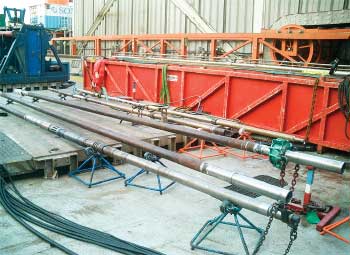 |
|
Fig. 1. The wireline tractor is laid out before assembly.
|
|
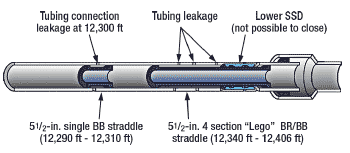 |
|
Fig. 2. The operator chose a wireline tractor/stroker combinationto isolate lower sliding side door and the tubing holes above the lower straddle.
|
|
Due to the 68° inclination at sleeve depth, the wireline tractor and the string weight would not be able to create enough force to engage the two elements. Therefore, a wireline stroker, Fig. 3, was included in the tool string. This tool provides 10,000-30,000 lb of force. Bi-directional movement is controlled from the surface.
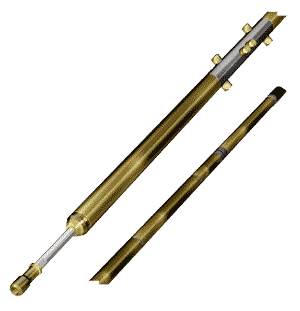 |
|
Fig. 3. Due to the 68° inclination at sleeve depth, a wireline stroker was included in the tool string.
|
|
The straddle operation started by bullheading the well to diesel, followed by straddle section installation. The operation was performed on a 5/16-in. mono-conductor cable. All together, five runs were required. First, the lower straddle was set conventionally. In Run 2 and 3 the tool forced the straddle packer elements into each other, providing the force for physical matching and proper sealing. Two strokes per element were performed. The first took seven seconds before saturation and the second stroke went directly into saturation. Typical stroke time is 25 sec.
In Run 4, the top packer section, with downhole power unit connected, anchored with the wireline tractor and wireline stroker. Two strokes were performed. Then, the upper packer latch was verified. Run 5 installed the straddle packer at 12,290-12,310 ft MD.
The operation took 32½ hr and enhanced production. Watercut was reduced from 85% to 5%, GOR decreased to 200 from 2,000 and oil production was boosted from 629 bpd to 5,661 bpd (100 to 900 cmd). The combination of a wireline tractor/stroker proved reliable with savings in personnel, logistics and planning.
Case 2. In a highly-deviated section in the toe of a U-shaped well, a custom-designed straddle packer assembly needed to be installed to isolate several intervals in an offshore well off northwest Norway. The well was an oil-producer completed with a 7-in. production tubing and a 7-in. perforated liner, Fig. 4. The objective was to isolate selected reservoir intervals at 130° inclination in the toe of the well to reduce GOR. The approach was to install a straddle packer assembly with a coiled-tubing tractor.
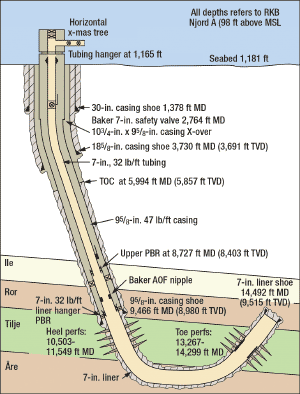 |
|
Fig. 4. The U-shaped well was an oil-producer completed with a 7-in. production tubing and a 7-in. perforated liner.
|
|
Based on computer simulations, it became clear that it would not be possible to reach the desired depth using coiled tubing and conventional extended-reach techniques alone. Computer simulations, using reduced friction coefficients and/or altered fluid densities, only helped marginally and indicated that the 2-in. (optimized taper) coiled tubing would go into a lockup 570 ft away from the target depth. A coiled-tubing tractor was recommended to extend the reach to target depth, Fig. 5.
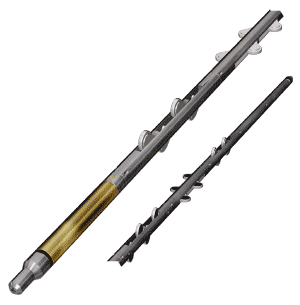 |
|
Fig. 5. A coiled-tubing tractor was recommended to extend the reach to target depth.
|
|
The coiled-tubing tractor is hydraulically powered. A turbine powered by the working fluid drives the system and moves the tool forward. The turbine allows more force to be generated, compared to wireline.
Computer simulations using 3,000-lb (13-kN) pull force on the straddle assembly in combination with the available coiled-tubing push, indicated that the well’s bottom could be reached. This would be the first time electrical tools were used in combination with the fluid-driven tractor.
A new adapter sub was required and was based on an existing coiled-tubing cable-head design, with added functionality to allow higher flowrates directed down through the emergency disconnect section, instead of the normal circulation path into the coiled-tubing annulus. A test of the new cable-head adapter with tractor was performed onshore to verify the flow-through characteristics, disconnect functionality, tractor performance and electrical integrity. Measured parameters from the test were later used when setting up the tools and tractor for the operation. The tractor top connector and compensator were redesigned to run the tool string for the straddle packer assembly.
Special attention was given to the connection between the setting tool and the casing collar locator. On standard tools, this is a relatively weak connection; it is meant for tools to be run on wireline. To ensure that tools were not accidentally lost-in-hole, the top adapter thread on the setting tool was changed to a CAL-B connection, which is larger and provides more resistance to bending forces. The packers were custom-made to 5.5-in. OD to pass a 5.75-in. AOF nipple and several doglegs in the well.
When running the straddle packer assembly into the toe section of the well, lock-up was experienced at 13,650-ft MD at 113° inclination-in accordance with the simulated lock-up depth. The CT tractor was then activated by pumping 37 gpm (140 lpm), successfully moving the straddle assembly downhole to 14,150-ft MD at 130° inclination. The straddle packer assembly was then pulled back to the setting interval.
An electrically operated hydrostatic setting tool was used to set the straddle packer assembly. This was the first time this particular tool combination was successfully placed in a well under live conditions, ending with a 260-ft straddle in the well.
The results of the operation were impressive: GOR was reduced to 1,600 from 3,000, while oil production was increased to 9,434 bpd (1,500 cmd). Due to the increased production, the operator had his investment returned within 35 days.
Case 3. July 2007 marked a breakthrough in reducing water production from single wells offshore Norway. The challenge was to set a plug in a horizontal well perforated over different zones. The well had severe crossflow from highly different reservoir pressures, which reduced productivity to a minimum. The high crossflow rate made the plug setting almost impossible. Flow simulation showed that the tool string assembly with an almost in-gauge plug had a very high risk of moving up during the setting process, which would eliminate the advantage of plugging off the lower zone.
The solution was to anchor the plug-setting tool string at the correct depth using a wireline stroker, while setting the plug conventionally. The tool was to be conveyed to the target zone by a wireline tractor. During this operation, it was used as an anchor to ensure the bridge plug was held in position long enough for it to be set.
Before the operation, a test was done for optimum functionality. The test was successful, but identified a need for modifications. The tool should be limited to a maximum pushing force of seven tons by a modified hydraulic relief valve to allow upward movement of the running tool. This was done to shear free from the plug during the setting sequence.
On site, the wireline stroker was used as an anchor to set the plug in the high crossflow. The bridge plug was set at 10,384 ft in 1,887 bpd (300 cmd) crossflow with a pressure differential of about 30 bar in a 5-in. liner. After setting the plug, a wireline tractor successfully installed a 23-ft straddle from 9,990 ft to 10,013 ft in one run to isolate a 10-ft water-producing interval, Fig. 6.
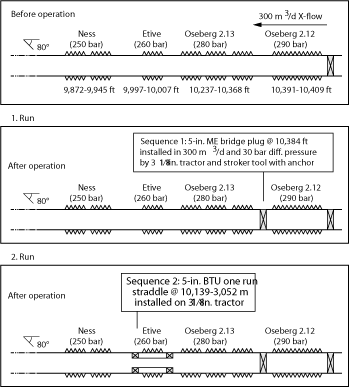 |
|
Fig. 6. After setting the plug, a wireline tractor installed a 23-ft straddle to isolate a 10-ft water-producing interval.
|
|
The well test data after water shutoff indicated that the water rate was reduced to 943 bpd (150 cmd) from 13,523 bpd (2,150 cmd). The oil rate was maintained at about 1,258 bpd (200 cmd), and watercut was reduced to 45% from 90%.
Over the last two years, produced-water handling capacity had restricted the field and pressure support in the closed-off zones was insufficient. The job is expected to improve total oil production at the field level. As an additional benefit, the operation reduced environmental impacts from improved produced-water handling.
The job was a world first and could not have been done without the wireline tractor and wireline stroker because of the force needed to set the plug in the high crossflow. StatoilHydro considers this operation a technological landmark.
CONCLUSIONS
When 250 million bbl of water are produced worldwide every day, these massive amounts come with high cost and environmental risks. With increased reservoir maturation, the challenge is not becoming easier.
The willingness of operators to attempt new approaches is crucial. Innovative methods may seem risky at first, but they can also turn into rewarding solutions. These cases demonstrate that wireline tractor services can provide a cost-effective solution for well intervention and protect the total well investment. It is now feasible to perform interventions on wireline that are economic and expand the envelope for performing repairs and modifications to new and existing wells. 
ACKNOWLEDGEMENT
The authors thank StatoilHydro and Welltec for permission to publish this article. In particular, we thank the companies for allowing the authors to draw on their international operational experience.
LITERATURE CITED
1 Dal Ferro, B. and Smith, M., “Global onshore and offshore water production,” Exploration & Production: The Oil and Gas Review 2007-OTC Edition, April 2007.
2 Aanensen, G. and Tykkhelle, B., “Monitoring oil-in-water in offshore production,” Produced Water Report for Engineers and Industry Professionals by Produced Water Society, World Oil, September 2007.
3 OSPAR Recommendation 2001/1for the Management of Produced Water from offshore Installations, OSPAR Recommendation 2001/1 adopted by OSPAR 2001 (OSPAR 01/18/1, Annex 5). Amended by OSPAR Recommendation 2006/4 (OSPAR 06/23/1, Annex).
|
THE AUTHOR
|
|
|
Brian Schwanitz earned a BSc in Applied Mining Geophysics from Michigan Technological University. Before joining Welltec in 2002, he worked for Schlumberger for 25 years in various product lines and managerial positions. He has served as an International Board member of ICoTA and authored numerous papers and articles. Vice President Brian Schwanitz was recently appointed Global Sales and Marketing Manager.
|
|
|
|
Paal Ludvik Jørgensen earned an Engineer degree in Process Technique at Bergen Ingeniør Høgskole in 1996 before joining StatoilHydro in 2004. At StatoilHydro, he worked as a production and well/completion engineer on Veslefrikk/Gullfaks in the North Sea. He is based at Visund SubSea, D&W in Bergen, Norway. Jørgensen is Well Plan Manager at the Visund Field where he is responsible for planning all interventions on the Visund Field, located in the Northern part of the North Sea.
|
|
|










